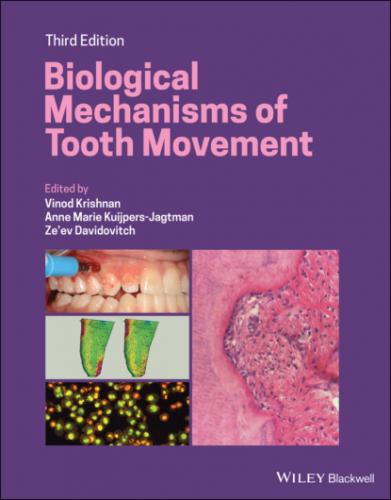Biological Mechanisms of Tooth Movement. Группа авторов
target="_blank" rel="nofollow" href="#ulink_a58bda05-c3df-5531-a060-06a877fce709">Figure 2.9 Third degree of biologic effect as portrayed in Schwarz article (1932). (a) Shows MZ, marginal side of pull; MD, marginal side of pressure; 0, tilt axis; AZ, apical side of pull; AD, apical side of pressure. (b) Marginal side of pressure, greatly enlarged: Z, tooth (dentine); C, cementum; H, resorption cavity reaching far into the dentine; P, periodontium; R, line of resorption on the alveolar wall, densely covered by osteoblasts; early stages of regeneration; A, compressed area of the periodontium, no nuclei of cells; U, signs of undermining resorption. (c) Sketch of the spring. The point of application on the tooth is shown at X.
(Source: Schwarz, 1932. Reproduced with permission of Elsevier.)
Figure 2.10 Fourth degree of biologic effect as portrayed in Schwarz article (1932) depicting osteophytes on the outer surface in the apical region. (a) The influence created by strong force applied in the direction of the arrow: P, pulp; D, dentine; C, cementum; K, old alveolar bone; O, osteophytes; Q, region of compression of the periodontium; R, region of resorption stretching over the newly formed osteophytes. (b) The osteophytes, O, were formed in the lumen of the canalis mandibulae (N, nervus mandibularis). At the region of compression, the old alveolar bone, K, is removed by undermining resorption, R. The young osteophytes were also attacked by the latter. Arrow and also P, C and D as in (a).
(Source: Schwarz, 1932. Reproduced with permission of Elsevier.)
Through his writings, Schwarz tried to indicate the methodological differences between the approaches made by Sandstedt and Oppenheim (Figure 2.11), and concluded that Oppenheim had euthanized his experimental animals several days after the appliance had been last activated, and Schwarz attributed this fact to the reason why Oppenheim saw only normal adaptation phenomena. Moreover, Oppenheim ignored the acute phase reactions and focused only on the stage of regeneration after the force had been exhausted. It seems more likely that what Oppenheim was describing was the response of cells of the periosteal and endosteal bone surfaces to the bending of the labial alveolar bone plate (Meikle, 2006).
Following Schwarz’s publication, Oppenheim performed additional studies on tissue reactions in mature monkeys (Macaca rhesus) to applications of light and heavy forces (Oppenheim, 1944). He concluded that with light forces, osteoclasts are mobilized at a very fast pace and attack bone by a uniform superficial lacunar resorption. These cells, called “primary osteoclasts,” stayed active in the site for almost 4 days (Figure 2.12). In contrast, the use of heavy forces resulted in crushing of the PDL, with a cutoff in all its nutritional supplies, resulting in undermining resorption. The direction of bone resorption comes from unintended sources, with an inflow of osteoclasts from adjacent unaffected areas. These osteoclasts, called “secondary osteoclasts,” persist until the crushed PDL, bone, and cementum are removed (Figure 2.12). Oppenheim further examined the hemorrhage formed by crushed blood vessels and found that the impaired nourishment along with encroachment of osteophytes and toxins from decomposed red blood cells lead to mobilization of osteoclasts from far off sites, called “tertiary osteoclasts” (Figures 2.13 and 2.14). All these cells were observed by application of higher amounts of force (240–360 g) to teeth. With these findings, Oppenheim advocated the use of intermittent forces, consisting of force application for a short period (1 day) followed by a rest period of longer duration (3 or 4 days). He considered this formula to be a biologic approach, but was later disproved by the evolution of mechanical devices of greater potential. He concluded that primary osteoclasts are the type, which is of great help to the orthodontist, and that only light forces can induce their production in abundance.
Figure 2.11 Comparative diagram of the theories put forward by Sandstedt (1904) and Oppenheim (1911) as drawn by Schwarz (1932). In (a), which depicts the theory of pressure (Sandstedt), the tooth moved by the force, P, tilts around an axis, O, lying a little apically from the center of the root. By this means two regions of pressure and pull arise, lying diametrically opposite. In the regions of pressure in the PDL, the old alveolar bone is resorbed (jagged line) and in the regions of pull, new bone is added (horizontal shading). Gray shading, alveolar bone without transformation. (b) This depicts the theory of transformation (Oppenheim, 1911, 1944). There is only one side of pressure and one side of pull. On both sides the alveolar bone opens into a transitional spongy bone, whose elements are arranged vertically to the surface of the tooth (horizontal shading). On the side of pressure, this newly formed transitional bone is resorbed (jagged line). On the side of pull, new bone is added. Gray shading indicates the old untransformed alveolar bone at a greater distance from the moved tooth,
(Source: Schwarz, 1932. Reproduced with permission of Elsevier.)
Figure 2.12 Higher magnification image from Oppenheim’s article (1944) showing labial alveolar crest. The aplastic zone facing the periodontium has for the greatest part disappeared, as has the crest itself. Where some aplastic bone is still present (ab), the secondary osteoclasts (Occ) are still at work removing it. No osteoclastic activity whatsoever is found at the periosteal smooth bone surface. The still remaining but decreased pressure caused the appearance of primary osteoclasts (Oc) and will be present for 2 days after force discontinuation. D, dentine; C, cementum; Pd, periodontal membrane; Po, formation of smooth periosteal bone surface; Opk, scarce osteophyte. ac, acellular cementum.
(Source: Oppenheim, 1944. Reproduced with permission of Elsevier.)
Figure 2.13 Higher
